
Who is an Investor?
Knowledge and behavioral preconditions in investors
#financial literacy
#investment behavior
#risk tolerance
#investor motivations
#psychological factors
#social influences
#discovery
#persona
Summary
Research was foundation for developing detailed investment personas. Research examines the relationship between financial literacy, risk tolerance, and investment behaviour. Findings indicate that higher financial literacy correlates with diversified portfolios, greater risk tolerance leads to bolder investment decisions, and unconscious biases alongside social environment strongly shape investment choices.
Conducted in June 2024.
Key takeaways
- Financial literacy is a strong predictor of portfolio diversification
- Risk tolerance is shaped by both measurable capacity (income, assets) and subjective willingness
- Social and cultural environment significantly affects investment adoption
- Investment motivations go beyond financial gain, including self-expression and emotional satisfaction
Scope and goal
Goal : To understand what it means to be an investor as a preliminary research for investment persona creation.
Focus:
- Definitions and characteristics of investors
- Relationship between financial literacy and investment activity
- Barriers and motivations to invest
- Influence of social, psychological, and demographic factors on investment behavior
Methods
- Secondary data analysis
- Data sources: Academic studies, government statistics, financial literacy reports, investment behavior research
Results
Investor profile:
- Higher income, higher education, higher financial literacy
- Long-term orientation and higher risk tolerance (age-dependent asset allocation)
- Influenced by social networks and access to investment platforms
Financial literacy link:
- Enables diversified portfolios and informed decision-making
- Low literacy acts as a barrier to stock market participation
Barriers to investing:
- Low income, low education, low risk tolerance, lack of access to resources, cultural norms, and limited knowledge
- Psychological factors: overconfidence, loss aversion, herd behavior, confirmation bias
Motivations for investing:
- Inflation protection, wealth growth, retirement planning, security in life events
- Utilitarian, expressive, and emotional benefits
- Achievement, epistemic, and experience-driven motivations
Sources
- Sconti, A.-Fernandez, D.: The importance of financial literacy: Evidence from Singapore. In: Journal of Financial Literacy and Wellbeing. 2023.
- Andrieș, A.M. et all.: Institutional Determinants of Households' Financial Investment Behaviour Across European Countries. In: Economic Analysis and Policy. 2023.
- Kłopocka, A.M.- Górska, R.: Forecasting Household Saving Rate with Consumer Confidence Indicator and its Components. In: European research studies Journal. 2021.